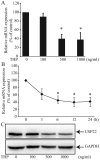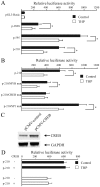Pirarubicin reduces USP22 expression by inhibiting CREB-1 phosphorylation in HeLa cells
- PMID: 31007754
- PMCID: PMC6468931
- DOI: 10.3892/etm.2019.7447
Pirarubicin reduces USP22 expression by inhibiting CREB-1 phosphorylation in HeLa cells
Abstract
The expression of ubiquitin specific peptidase 22 (USP22) is upregulated in several types of cancer, and has been implicated in tumorigenesis. Pirarubicin (THP), an anthracycline antineoplastic drug, can induce apoptosis of several types of cancer cells. However, the molecular mechanisms underlying the action of THP remain to be elucidated. In the current study, treatment with THP induced HeLa cell apoptosis and decreased USP22 expression in a dose- and time-dependent manner. THP reduced the USP22 promoter-regulated luciferase activity, regardless of the mutation of transcriptional activator MYB or E3 ubiquitin-protein ligase SP1 binding sequences; however, this effect was abrogated by the mutation of cyclic AMP-responsive element-binding protein (CREB) binding sequence in HeLa cells. Furthermore, the inhibition on the USP22 promoter activity by THP was not affected by overexpression of CREB-1 in HeLa cells. Additionally, treatment with THP significantly decreased the phosphorylation of CREB-1 at ser133 in HeLa cells. Quantitative chromatin immunoprecipitation assay revealed that THP significantly inhibited the binding of CREB-1 to the USP22 promoter in HeLa cells. The present study demonstrated that THP decreased USP22 expression and promoted HeLa cell apoptosis partially by inhibiting the phosphorylation of CREB-1. The current results may provide novel insights into the molecular mechanisms underlying the pharmacological effect of THP on cancer cell apoptosis.
Keywords: HeLa; cyclic AMP-responsive element-binding protein-1; phosphorylation; pirarubicin; ubiquitin specific peptidase 22.
Figures





Similar articles
-
PKA/CREB regulates the constitutive promoter activity of the USP22 gene.Oncol Rep. 2015 Mar;33(3):1505-11. doi: 10.3892/or.2015.3740. Epub 2015 Jan 20. Oncol Rep. 2015. PMID: 25607216
-
[Ubiquitin specific peptidase 22 regulates the transcription activity of mitogen-activated protein kinase kinase 6 gene].Zhong Nan Da Xue Xue Bao Yi Xue Ban. 2019 Feb 28;44(2):122-127. doi: 10.11817/j.issn.1672-7347.2019.02.002. Zhong Nan Da Xue Xue Bao Yi Xue Ban. 2019. PMID: 30837379 Chinese.
-
p38 mitogen-activated protein kinase inhibits USP22 transcription in HeLa cells.Biomed Rep. 2015 Jul;3(4):461-467. doi: 10.3892/br.2015.450. Epub 2015 Apr 16. Biomed Rep. 2015. PMID: 26171149 Free PMC article.
-
Regulation of somatostatin gene transcription by cyclic adenosine monophosphate.Metabolism. 1996 Aug;45(8 Suppl 1):4-7. doi: 10.1016/s0026-0495(96)90068-2. Metabolism. 1996. PMID: 8769368 Review.
-
Ubiquitin Specific Peptidase 22 Regulates Histone H2B Mono-Ubiquitination and Exhibits Both Oncogenic and Tumor Suppressor Roles in Cancer.Cancers (Basel). 2017 Dec 6;9(12):167. doi: 10.3390/cancers9120167. Cancers (Basel). 2017. PMID: 29210986 Free PMC article. Review.
Cited by
-
The Role of Deubiquitinating Enzymes in Primary Bone Cancer.Mol Biotechnol. 2025 Aug;67(8):3027-3040. doi: 10.1007/s12033-024-01254-y. Epub 2024 Aug 23. Mol Biotechnol. 2025. PMID: 39177860 Review.
-
Inhibition of miR-15a-5p Promotes the Chemoresistance to Pirarubicin in Hepatocellular Carcinoma via Targeting eIF4E.Comput Math Methods Med. 2021 Nov 13;2021:6468405. doi: 10.1155/2021/6468405. eCollection 2021. Comput Math Methods Med. 2021. Retraction in: Comput Math Methods Med. 2023 Nov 1;2023:9867851. doi: 10.1155/2023/9867851. PMID: 34812269 Free PMC article. Retracted.
-
Deubiquitination in prostate cancer progression: role of USP22.J Cancer Metastasis Treat. 2020;6:16. doi: 10.20517/2394-4722.2020.23. Epub 2020 Jun 18. J Cancer Metastasis Treat. 2020. PMID: 34660907 Free PMC article.
References
-
- Zou HY, Wu HL, Zhang Y, Li SF, Nie JF, Fu HY, Yu RQ. Studying the interaction of pirarubicin with DNA and determining pirarubicin in human urine samples: Combining excitation-emission fluorescence matrices with second-order calibration methods. J Fluoresc. 2009;19:955–966. doi: 10.1007/s10895-009-0495-6. - DOI - PubMed
LinkOut - more resources
Full Text Sources
Research Materials
